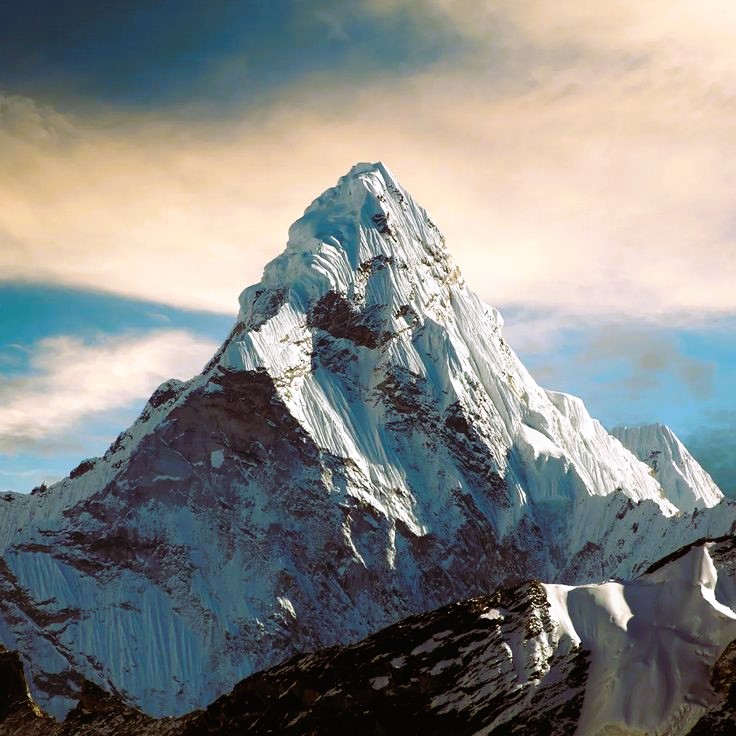Mount Everest, the highest mountain in the world, stands at 8,848.86 meters (29,031.7 feet) above sea level. It is located in the Himalayas, on the border between Nepal and Tibet (China). While most people know that Everest is the tallest peak, there are many lesser-known facts about this iconic mountain. From its formation to the challenges faced by climbers, here are some surprising and fascinating facts about Mount Everest.
1. Mount Everest Is Still Growing
Mount Everest is not a fixed height; it continues to grow every year. This is because of the movement of the Earth’s tectonic plates. The Indian plate is slowly pushing against the Eurasian plate, causing the Himalayas, including Everest, to rise by about 4 millimeters (0.16 inches) per year. Over thousands of years, this process has made Everest the tallest mountain on Earth.
In 2020, Nepal and China officially measured Everest’s height again, confirming it at 8,848.86 meters (29,031.7 feet), slightly higher than previous measurements.
2. The First People to Reach the Top May Not Have Been Edmund Hillary and Tenzing Norgay : Mount Everest
Sir Edmund Hillary from New Zealand and Tenzing Norgay, a Sherpa from Nepal, are famous for being the first people to reach the summit of Mount Everest on May 29, 1953. However, some historians believe that two earlier climbers, George Mallory and Andrew Irvine, may have reached the top in 1924.
Mallory and Irvine disappeared near the summit, and their bodies were not found for many years. In 1999, Mallory’s body was discovered, but his camera was missing. If the camera is ever found and developed, it could prove whether they reached the top before perishing on their way down.
3. The Mountain Has Several Different Names : Mount Everest
Although the world knows it as Mount Everest, the mountain has several other names. In Nepal, it is called Sagarmatha, which means “Goddess of the Sky” in Sanskrit. In Tibet, it is known as Chomolungma, meaning “Goddess Mother of the World.” The British named it Everest in 1865 after Sir George Everest, a British surveyor-general of India.
Many people argue that the mountain should be called by its local names rather than the one given by the British.
4. The Death Zone: The Most Dangerous Part of the Mountain : Mount Everest

At an altitude of 8,000 meters (26,247 feet) and above, Mount Everest has a section known as the “Death Zone.” In this area, the air is so thin that there is only about one-third of the oxygen available at sea level. Without supplemental oxygen, climbers struggle to breathe, and their bodies begin to shut down.
The Death Zone is where most climbers lose their lives. The extreme cold, high winds, and low oxygen levels make it incredibly dangerous. Many climbers suffer from frostbite, hallucinations, and altitude sickness, which can be fatal.
5. Hundreds of Bodies Remain on the Mountain : Mount Everest
Over 300 people have died while trying to climb Mount Everest. Because of the extreme conditions, many of their bodies have never been recovered. In fact, some of these bodies are now landmarks that climbers use to navigate the trail.
One of the most famous is “Green Boots,” the frozen body of a climber wearing green boots. It lies on a well-known part of the trail and has been there since 1996. Removing bodies from Everest is nearly impossible because it is too dangerous and expensive.
6. Everest Is Home to a Tiny Spider : Mount Everest
Surprisingly, even at high altitudes, there is life on Everest. The Himalayan jumping spider (Euophrys omnisuperstes) is one of the highest-living creatures in the world. These tiny spiders can be found at altitudes of up to 6,700 meters (22,000 feet).
They survive by eating insects that are blown up the mountain by strong winds. This incredible adaptation makes them one of the toughest creatures on Earth.
7. There Is a “Traffic Jam” on Everest : Mount Everest
Climbing Mount Everest has become so popular that there are often long lines of climbers waiting to reach the summit. In recent years, the number of climbers has increased dramatically, leading to traffic jams at high altitudes.
In 2019, a record number of climbers attempted to reach the summit, causing severe delays. Many climbers had to wait for hours in the freezing cold, and some ran out of oxygen before they could descend safely. Overcrowding has become a major problem, making Everest even more dangerous.
8. Everest’s Weather Is Brutal : Mount Everest
The weather on Mount Everest is extremely harsh. The temperature at the summit can drop as low as -60°C (-76°F) in winter. Even in the warmer months, strong winds and sudden storms make climbing very difficult.
The jet stream, a high-altitude wind current, often brings winds of over 200 mph (322 km/h) to the mountain. These winds are strong enough to blow climbers off the mountain.
9. It Takes Weeks to Climb Everest : Mount Everest
Climbing Mount Everest is not a one-day trip. It usually takes six to ten weeks to complete the expedition.
- Acclimatization: Climbers spend weeks at different camps to get used to the thin air.
- Climbing in Stages: They move between camps slowly, going up and down multiple times to adjust their bodies.
- Summit Attempt: Only after weeks of preparation do they try to reach the top.
The long duration of the climb makes it one of the toughest challenges in the world.
10. Everest Was First Measured in 1856 : Mount Everest
Mount Everest was first measured in 1856 by the British surveyor Andrew Waugh, who estimated its height at 8,840 meters (29,002 feet). This measurement was surprisingly close to modern measurements, despite the limited technology of the time.
Modern technology, such as GPS and satellites, has allowed scientists to measure Everest more accurately, but the mountain’s height continues to change slightly due to geological activity.
11. It Costs a Fortune to Climb Everest : Mount Everest
Climbing Mount Everest is not just physically demanding—it is also extremely expensive. The cost of an Everest expedition can range from $30,000 to $100,000 or more.
The expenses include:
- Climbing Permits: Nepal charges around $11,000 per climber for a permit.
- Guides and Sherpas: Most climbers hire experienced guides and Sherpas for safety.
- Equipment: Specialized gear, oxygen tanks, and clothing are required for survival.
Despite the high cost, hundreds of climbers attempt to summit Everest every year.
12. Sherpas Are the Unsung Heroes of Everest : Mount Everest
The Sherpas are the native people of the Everest region, and they play a crucial role in helping climbers reach the summit. They are known for their incredible strength, endurance, and ability to survive at high altitudes.
Sherpas work as guides, carrying heavy loads, setting up ropes, and assisting climbers in dangerous conditions. Many of them have climbed Everest multiple times, yet they do not always get the recognition they deserve.
One of the most famous Sherpas is Kami Rita Sherpa, who has climbed Everest 28 times, holding the record for the most ascents.
Conclusion
Mount Everest is not just the tallest mountain in the world; it is also one of the most fascinating and dangerous places on Earth. From its continuous growth to the mysteries of early climbers, there are many unknown facts about Everest that make it truly unique.
Despite the risks, Everest continues to attract adventurers from around the world. Whether you dream of climbing it or just enjoy learning about it, Mount Everest will always remain a symbol of human determination and nature’s power.




Your article helped me a lot, is there any more related content? Thanks!
I don’t think the title of your article matches the content lol. Just kidding, mainly because I had some doubts after reading the article.
I don’t think the title of your article matches the content lol. Just kidding, mainly because I had some doubts after reading the article.
Thank you for your sharing. I am worried that I lack creative ideas. It is your article that makes me full of hope. Thank you. But, I have a question, can you help me?
Your article helped me a lot, is there any more related content? Thanks!
I have been exploring for a little for any high-quality articles or blog posts on this kind of area . Exploring in Yahoo I at last stumbled upon this website. Reading this info So i am happy to convey that I’ve a very good uncanny feeling I discovered exactly what I needed. I most certainly will make sure to do not forget this website and give it a glance on a constant basis.